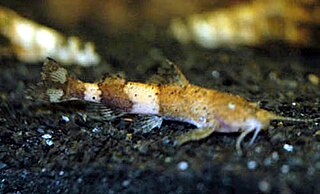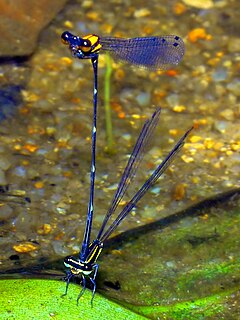
Erethistidae are a family of catfishes that originate from southern Asia. It includes about 45 species.

Pseudolaguvia is a genus of South Asian river catfishes. These species inhabit hill streams and large rivers. P. tenebricosa is found in fast running, clear water; the river has a sandy bottom and numerous rocks and boulders and aquatic vegetation is absent. P. inornata is from clear, shallow, moderately flowing streams with a predominantly sandy bottom. P. muricata is found in clear, shallow, slow-flowing streams with a mixed substrate of sand and detritus; these fish are found amongst detritus in areas with current. P. ferula is also found in swift flowing waters with a mixed rocky/sandy bottom.
Oreoglanis is a genus of fish in the family Sisoridae native to Asia. These fish live in fast-flowing streams in China, mainland Southeast Asia and the Indian subcontinent. They are mainly distributed in the Mekong, upper Salween and Irrawaddy River drainages. They range from the Brahmaputra basin to the Lam River drainage in central Vietnam. They are easily distinguished from other catfishes by their strongly depressed head and body and greatly enlarged paired fins that have been modified to form an adhesive apparatus. The flattened shape of these fish and the large pectoral and pelvic fins provide essential adhesion in the fast-flowing waters they live in.

Akysis is the largest genus of catfishes of the family Akysidae.
Amblyceps carinatum is a species of catfish belonging to the family Amblycipitidae. It is only known from the upper part of the Irrawaddy River basin in Myanmar.

Batasio is a genus of catfish of the family Bagridae. These small fish are found in fast-flowing hillstreams throughout South and mainland Southeast Asia.
Amblyceps is a genus of fish in the family Amblycipitidae. The genera Amblyceps and Liobagrus are sister group pair that is, in turn, sister to Xiurenbagrus. These species are easily distinguished by the presence of pinnate processes along with the median caudal-fin rays, a prominent cup-like skin flap above the base of the pectoral spine ,and the adipose fin largely separate from the caudal fin. In most species the caudal fin is deeply forked; A. apangi and A. murraystuarti differ in having their caudal fin truncate. Amblyceps species may reach about 100 millimetres (3.94 in) SL.

Prodasineura, the Asian threadtails, is a genus of damselflies in the family Protoneuridae. All the Afrotropical species formerly in this genus are now placed in Elattoneura, the African threadtails. Dijkstra et al. (2014) moved the genus from Protoneuridae to Platycnemididae based on molecular phylogenetic research.

Cavefish or cave fish is a generic term for fresh and brackish water fish adapted to life in caves and other underground habitats. Related terms are subterranean fish, troglomorphic fish, troglobitic fish, stygobitic fish, phreatic fish and hypogean fish.

Chiloglanis batesii is a species of upside-down catfish found widely in Western and Central Africa. This species grows to a length of 4.7 centimetres (1.9 in) TL.
Bagarius bagarius, also known as the devil catfish, dwarf goonch or goonch, is a species of catfish in the genus Bagarius. It is generally reported as being found in large and medium rivers in South Asia, and is likely synonymous with B. yarrelli.

Ompok bimaculatus, known as butter catfish, is a species of sheatfishes native to Asian countries such as Bangladesh, India, Pakistan, and Sri Lanka, but recently identified in Myanmar.
Pseudolaguvia ferruginea is a species of sisorid catfish from the Raidak River, which is a tributary of the Sankosh River, which is in turn a tributary of the Brahmaputra River in India. This species reaches a length of 2.9 cm (1.1 in).
Pseudolaguvia foveolata is a species of sisorid catfish from the Tista River, which is a tributary of the Brahmaputra River in northern West Bengal, India. This species reaches a length of 3.0 cm (1.2 in).
Pseudolaguvia spicula is a species of sisorid catfish from the Surma-Meghna River system in India and Bangladesh. This species reaches a length of 3.1 cm (1.2 in).
Pseudolaguvia virgulata is a species of sisorid catfish from the Barak River drainage in Mizoram, India. This species reaches a length of 2.9 cm (1.1 in).
Pseudolaguvia magna is a species of sisorid catfish from the Jiya stream in Arunachal Pradesh, India. This species reaches a length of 4.7 cm (1.9 in).
Pseudolaguvia shawi is a species of sisorid catfish from waters in Darjeeling, Siliguri Terai and Sikkim in India. This species reaches a length of 3.8 cm (1.5 in).
The Painted Catfish, Pseudolaguvia ribeiroi is a species of sisorid catfish from Nepal and India. This species reaches a length of 10.0 cm (3.9 in).
Pseudolaguvia tuberculata is a species of sisorid catfish from Myanmar. This species reaches a length of 3.0 cm (1.2 in).








